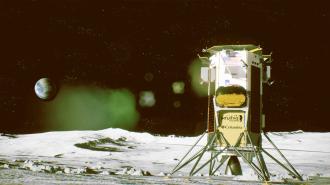Houston-based startup Intuitive Machines just made history with the first private moon landing — but when the spacecraft’s laser navigation system failed in the final hours before landing, the mission became a nailbiter.
Smoothe start: A SpaceX rocket launched Intuitive’s NASA-funded lander, dubbed “Odysseus,” early in the morning of February 15. Within an hour, Intuitive announced that it was in communication with the spacecraft, which was healthy and en route to the moon.
Six days later, Odysseus entered the moon’s orbit. Intuitive reported that the lander was still in “excellent health,” shared several images it snapped from lunar orbit, and announced plans to touchdown on the moon’s surface around 5:30 pm ET the next day.
“We weren’t planning to use it in line with the actual mission coming down to the landing, but now we are.”
Prasun Desai
Rough landing: Trouble started a few hours before the scheduled landing, when Intuitive discovered that Odysseus’ laser navigation system had failed. This tech is used to determine the lander’s altitude and speed — essential information for a successful landing.
Thankfully, Odysseus was carrying six science experiments for NASA, and one of them was a navigation system.
“We weren’t planning to use it in line with the actual mission coming down to the landing, but now we are,” Prasun Desai, the deputy associate administrator for NASA’s space technology mission directorate, said during NASA’s livestream of the moon landing.
“What an outstanding effort … Welcome to the moon.”
Steve Altemus
Intuitive sent Odysseus on an extra lap around the moon to buy time to write a software patch that would allow it to use NASA’s experiment to guide the lander to the moon’s surface. It then beamed the patch up and began the lander’s final descent.
At 6:23 pm, Odysseus reached the moon, but it took another 15 minutes for Intuitive to report that the lander was transmitting a signal (albeit a weak one) that meant it had survived the moon landing.
“What an outstanding effort,” said CEO Steve Altemus. “I know this was a nailbiter, but we are on the surface, and we are transmitting. Welcome to the moon.”
Looking ahead: On February 23, Intuitive shared an update that Odysseus was “alive and well” on the moon’s surface. Its solar-powered battery was charging, and it was collecting data to send back to Earth.
If all goes as planned, the lunar lander will operate for at least seven days, testing out tech that NASA hopes will help it return humans to the moon through future Artemis missions.
The big picture: Intuitive’s successful moon landing wasn’t just a big moment for the startup and the commercial space industry — it also marked the first time a US spacecraft has reached the lunar surface since the Apollo era.
“Today, for the first time in more than a half century, the US has returned to the moon,” said NASA Administrator Bill Nelson. “Today, for the first time in the history of humanity, a commercial company — an American company — launched and led the voyage up there.”
“Congratulations to everyone involved in this great and daring quest at Intuitive Machines, SpaceX, and right here at NASA,” he added. “What a triumph!”
We’d love to hear from you! If you have a comment about this article or if you have a tip for a future Freethink story, please email us at [email protected].




